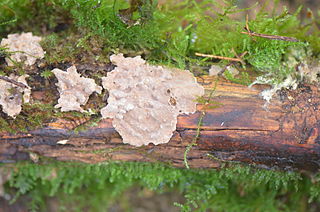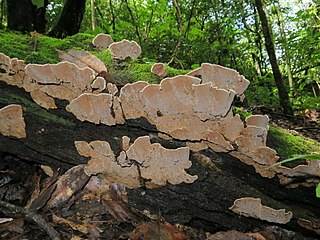
Peniophora albobadia is a species of crust fungus in the family Peniophoraceae. It is a saprobic fungus, forming spreading crusts on the bark of decaying twigs and fallen branches of many hardwood species. The species epithet is derived from albo-, white, and badi- meaning reddish-brown, the epithet accurately describing the vivid contrast between the fertile area and the margin.

The Phanerochaetaceae are a family of mostly crust fungi in the order Polyporales.
Candelabrochaete is a genus of crust fungi in the family Phanerochaetaceae.

Podoscypha is a genus of fungi in the family Meruliaceae. The genus has a widespread distribution, especially in tropical regions, and contains about 35 species.
Hjortstamia is a genus of corticioid fungi in the family Phanerochaetaceae. It was circumscribed by French mycologists Jacques Boidin and Gérard Gilles in 2003.

Hyphoderma is a genus of crust fungi in the family Meruliaceae. It was circumscribed by German botanist Karl Friedrich Wilhelm Wallroth in 1833.

Hypochnicium is a genus of corticioid fungi in the family Meruliaceae. The genus was circumscribed by mycologist John Eriksson in 1958.

Dentocorticium is a genus of six species of poroid fungi in the family Polyporaceae. The genus was revised in 2018, with several new species added and some older species transferred to other genera, based on phylogenetic analyses.
Forest pathology is the research of both biotic and abiotic maladies affecting the health of a forest ecosystem, primarily fungal pathogens and their insect vectors. It is a subfield of forestry and plant pathology.

The sirex woodwasp is a species of horntail, native to Europe, Asia, and northern Africa. Adults vary in length from 9 to 36 mm.

Clavulicium is a genus of corticioid fungi in the family Stereopsidaceae. It was formerly placed in the family Clavulinaceae in the order Cantharellales but was found to belong in a new order along with Stereopsis in 2014. The widespread genus was circumscribed by the French mycologist Jacques Boidin in 1957. The spores and the basidia of species in the genus are similar to those in Clavulina but also similar to those in Stereopsis. Clavulicium globosum is now a species of Stereopsis.

Franck Boidin is a French foil fencer. He won an individual bronze medal at the 1996 Summer Olympics and in the 2001 World Championships. He is also twice team World champion.

Amylostereum is the single genus in the fungal family Amylostereaceae. The genus currently comprises four saprotrophic and parasitic species, which live off living or dead wood. The Amylostereaceae cause white rot in the wood by disintegrating the tissue component lignin. They produce crust-like, partially wavy fruit bodies on the surface of infested trees, which are similar to those produced by Stereum species.

Amylostereum chailletii is a species of crust fungus. It was originally described in 1822 as Thelephora chailletii by Christian Hendrik Persoon in 1822, and given its current name when it was moved into Amylostereum by Jacques Boidin in 1958. It causes a white rot, especially in spruce and fir species.
Amylostereum ferreum is a species of crust fungus in the family Amylostereaceae.

Amylostereum laevigatum is a species of crust fungus in the family Amylostereaceae. Originally named Thelephora laevigata by Elias Fries in 1828, it was given its current name when transferred to the genus Amylostereum by French mycologist Jacques Boidin in 1958.

Xylobolus frustulatus, commonly known as the ceramic fungus or ceramic parchment, is an inedible species of crust fungus in the Stereaceae family. The fruit body forms small, hard, flat crust-like aggregations that resemble broken pieces of ceramic tile. These pieces are initially whitish before turning yellow-brown to gray-brown in age. The spore-bearing cells cover the upper surfaces of the fruit body. A saprobic species, it grows on well-decayed oak wood in Asia, northern Europe, and North America.
Boidinella is a genus of fungi in the family Hydnodontaceae. The genus was described in 2011 by mycologist Karen Nakasone to contain B. cystidiolophora and the type species B. globulispora. These species have soft, effused fruit bodies and spherical to ellipsoid basidiospores that have smooth, hyaline (translucent) and cyanophilous walls. The genus name honors French mycologist Jacques Boidin.

Xylobolus subpileatus is a widely distributed species of crust fungus in the family Stereaceae. It was first described scientifically in 1849 by Miles Joseph Berkeley and Moses Ashley Curtis, who considered the fungus a species of Stereum closely related to but distinct from Stereum rugosum. The original collections were made from specimens growing on dead trunks in the United States of Ohio and South Carolina. Xylobolus subpileatus was given its current name by French mycologist Jacques Boidin when he transferred it to the genus Xylobolus in 1958.
Myriothele is a fungal genus in the family Polyporaceae. It is a monotypic genus, consisting of the single species Myriothele philippiae, a toothed crust fungus found in Réunion.














